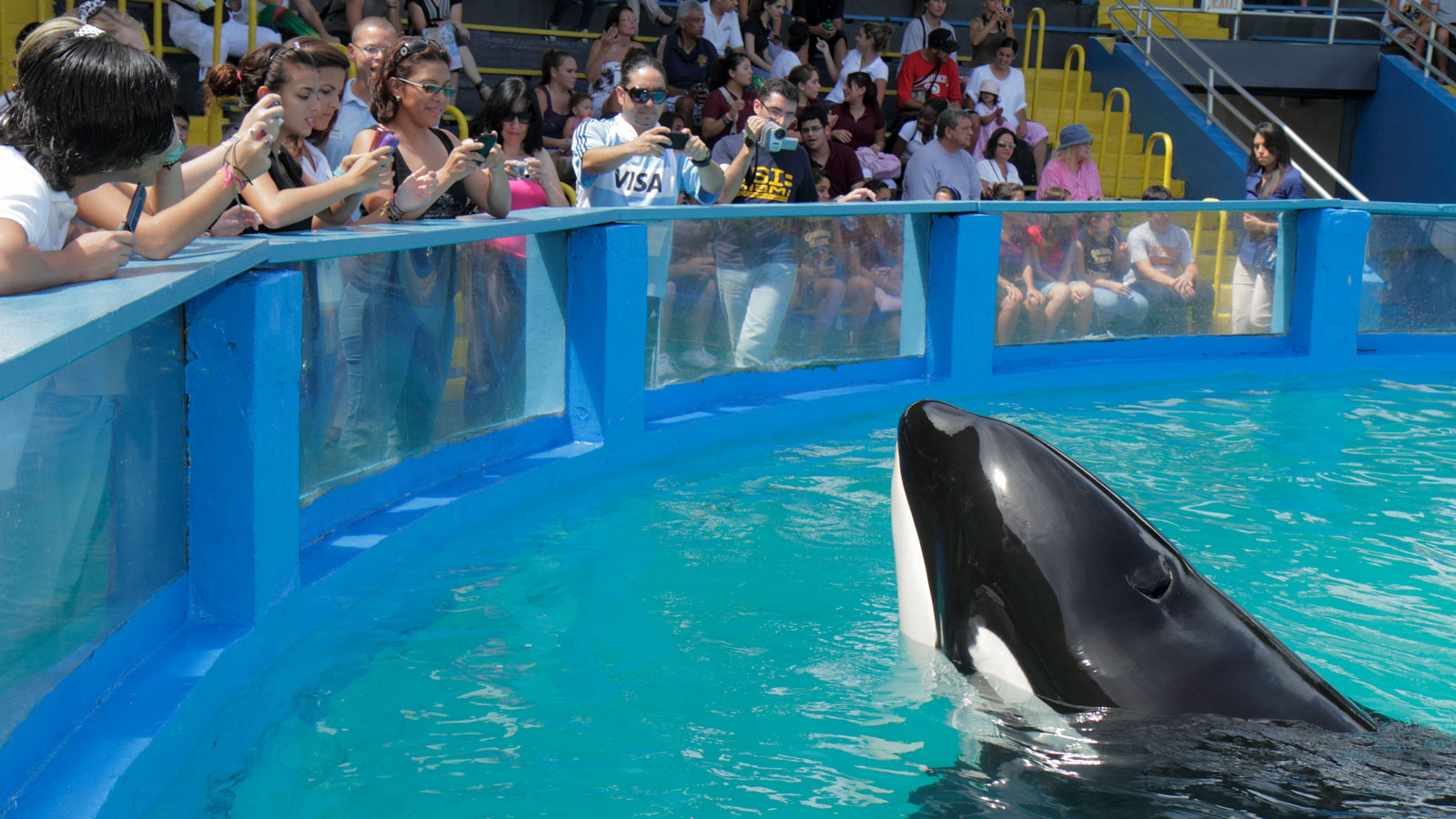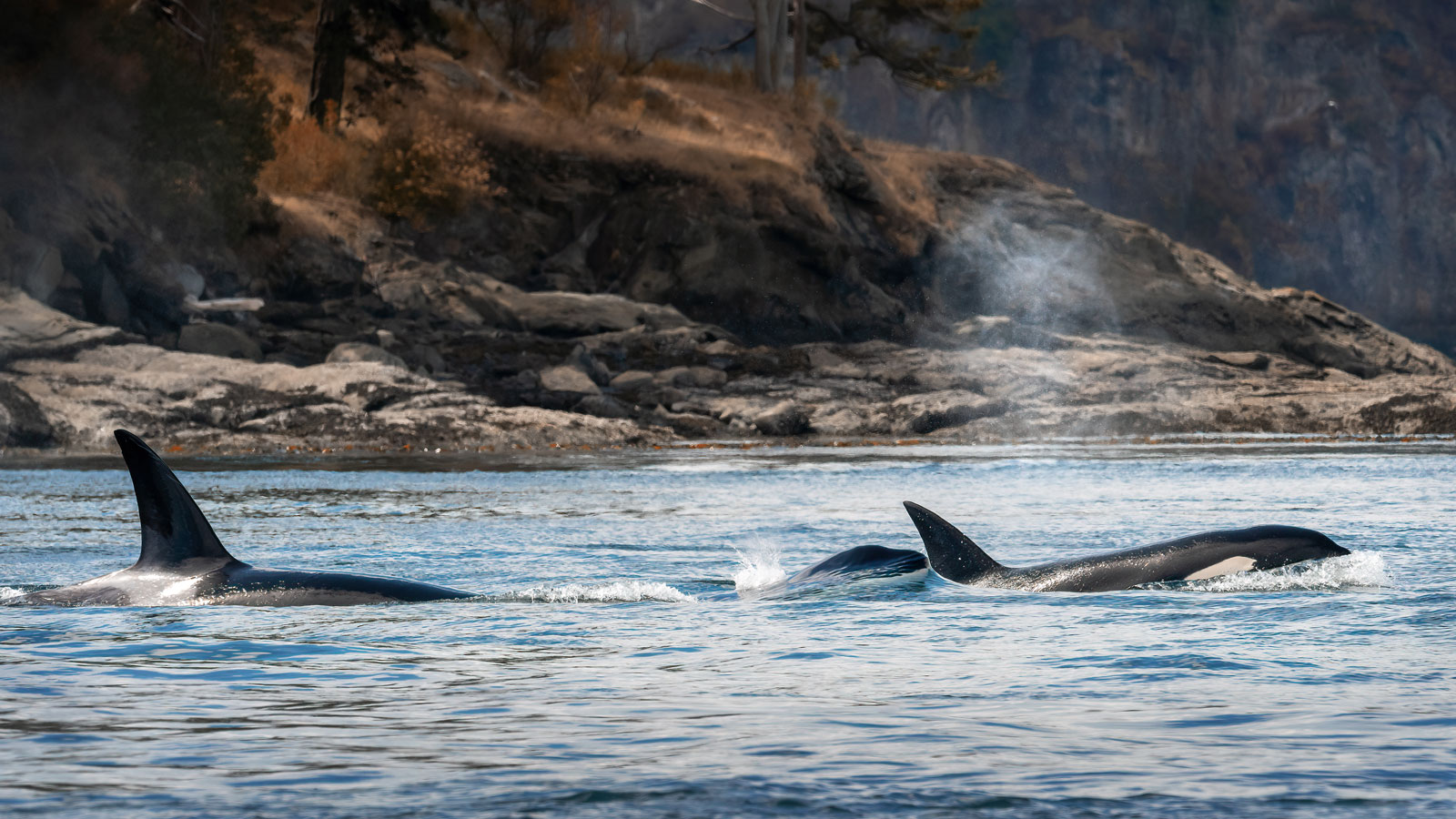Lummi tribal matriarchs Raynell Morris and Ellie Kinley both worked for Lummi Nation’s Sovereignty and Treaty Protection Office and fought to protect Xwe’chi’eXen (Cherry Point) from what would have been North America’s largest coal-export facility. Now, as leaders of the nonprofit Sacred Sea, they are spearheading the Salish Sea Campaign, including the effort to rematriate the last remaining captive Southern Resident orca.
We know the killer whale who lives in a small concrete tank at the Miami Seaquarium as Sk’aliCh’elh-tenaut. Trainers and activists call her Tokitae, while her stage name is Lolita. She has been held captive since the summer of 1970, when men with a $100 “take” permit, speedboats, nets, and explosives surrounded about 80 Southern Resident killer whales in Penn Cove on Whidbey Island, just north of Seattle. The men hauled out seven young ones, including Sk’alich’elh-tenaut, while their parents cried out nearby.
In June, the U.S. Department of Agriculture, which regulates zoos and aquariums, inspected Miami Seaquarium and found that Sk’aliCh’elh-tenaut lives in unsafe and unhealthy conditions. We are working with members of our tribe, the Lummi Nation, to bring her home to the Salish Sea.
Her story is part of a larger survival story.
Our people are survivors of the Great Flood, a long-ago time when the seas rose so high that our coast-dwelling ancestors had to take refuge on a mountaintop. Because they understood the land, the air, and the water, they knew when danger was coming and how to save themselves. Today, the seas are rising once again, and other disasters are unfolding. We believe that ancestral wisdom can again guide us — all of us — to safety. Part of our work to save ourselves is saving Sk’aliCh’elh-tenaut.
We have lived with killer whales since time immemorial and call them qwe’lhol’mechen, the people beneath the waves, because we see them as people whose cetacean regalia allows them to live underwater. Western science is now starting to understand, in its own way, that orcas are indeed very much like humans in terms of lifespan, intelligence, social complexity, communicative abilities, and capacity for love.
Our teachings hold that we have kinship bonds — as well as cultural and spiritual ties — to a particular clan of killer whales who live in the Salish Sea. They are our relatives, and so we call the J, K, and L pods of the Southern Resident orcas by their Lummi family name, Sk’aliCh’elh (Sk’aliCh’elh-tenaut means “daughter of Sk’aliCh’elh”).
We are taught that our Lummi and Sk’aliCh’elh families mirror each other. Our connection to the Salish Sea defines our people, as it does with the orcas. Salmon is essential to our identity and survival, as it is with the orcas. Our Lummi notion of “self” is inseparable from kinship and community; so, too, it is with the orcas. Family is sacred to us all.
Witness Tahlequah, who attracted international attention in 2018 for her public ritual of grief during which she carried the corpse of her newborn for 17 days and over 1,000 miles, moving “people above the waves” the world over. Tahlequah grieved along the Olympic Peninsula and waters off Washington State and British Columnbia. In the Salish Sea, the Southern Resident killer whales still avoid Penn Cove, the site where so many of their children were stolen.
In the 1960s and ’70s, about one-third of the Southern Resident orca population was captured and sold to aquariums and theme parks. For several decades, many of our own Lummi children were taken and sent away to boarding schools and foster care. Bringing those children back into our families and community has been healing. Sk’aliCh’elh children were sold to marine parks, where most of them died.
But Sk’aliCh’elh-tenaut is still alive. She has survived more than 50 years in captivity.
In a barren, dilapidated, 80-by-35-foot concrete tank, Sk’aliCh’elh-tenaut cannot dive deep or hunt salmon. She cannot escape the Florida sun or hurricanes. As the USDA report noted, she has suffered injuries while performing a routine that her own veterinarian called dangerous (that veterinarian was, coincidentally, fired shortly after the report was released). While some of these problems have been fixed, the structural issues will be inherited by the Dolphin Company, which in August announced it was purchasing the Miami Seaquarium.

We are extending an invitation to the Dolphin Company, as we did to the previous owners, to work with us to right a wrong done long ago. In addition to calling for her rematriation, we are also calling for an immediate independent, comprehensive medical evaluation and behavioral assessment, and assurance that Sk’aliCh’elh-tenaut’s physical needs are being met.
But her needs can never be truly met in a concrete tank, where, away from her family, she is denied not only her freedom but her very sense of self. We’ve been told by observers that Sk’aliCh’elh-tenaut often lies listlessly at the bottom of the pool. We are hopeful that the Dolphin Company’s stated desire to “explore the best options for Lolita” means that it will consider meeting and collaborating with us to return her to the Salish Sea.
Sk’aliCh’elh-tenaut does not belong to any company. She belongs to her family, she belongs to the Salish Sea, she belongs to herself. It is our Xa xalh Xechnging (sacred obligation) to bring her home. Her spirit is strong, as is ours.
As Lhaqtemish people, we are guided by our ancestors and the principle of A’ahs’qe’xie, loosely translated as the idea that everything is connected to every other thing, and that each connection has its own story, purpose, and energy. The image of a sacred, multidimensional web may be helpful as we tell this story.
Because this is where you enter the story.
You are part of this web. Everyone is. Western civilization has taught most of us to disregard this sacred web of life, to divorce ourselves from nature, to think of the environment as something outside of and apart from us. It has taught us that “man has dominion everywhere” and therefore that nature is a resource to be exploited rather than the web that creates and sustains us.
The web of life, and our place in it, has become ragged and fragile.
So what does one killer whale have to do with all this? The sacred web of life is unseen strand by strand, and it is torn strand by strand. And so it must be repaired strand by strand.
Sk’aliCh’elh-tenaut is a strand that can be repaired right here, right now.
Sk’aliCh’elh-tenaut does not belong to any company. She belongs to her family, she belongs to the Salish Sea, she belongs to herself.
As a whale in her mid-50s, Sk’aliCh’elh-tenaut is middle-aged. J-pod matriarch Granny was thought to be more than 100 years old when she died; L-pod matriarch Ocean Sun was born in 1928 and is believed to be Sk’aliCh’elh-tenaut’s mother. Grandmothers lead the pods. Sk’aliCh’elh-tenaut still sings the L-pod song her mother taught her when she was a baby. Family is everything to these killer whales. Bringing Sk’aliCh’elh-tenaut home will heal a very specific wound: It will make her family whole again.
Our late beloved hereditary chief of Lummi Nation, Tsilixw, told us that if we heal our orca family, if we heal the salmon, if we heal the Salish Sea, we will heal ourselves. We believe he meant our Lummi selves and also, broadly, our human selves, our species.
Our work to bring Sk’aliCh’elh-tenaut home is supported by Indigenous peoples throughout the world because it mirrors efforts to protect their homelands, sacred species, and ancestral lifeways. Indigenous worldviews and ways of being are based on deep knowledge of a specific place, a sense of oneness with Nature, and practices of reciprocity. When we harvest, we take only enough, and we give back.
This past spring, Lummi tribal members traveled to Miami and joined with members of the Seminole tribe, on whose homeland the Seaquarium is built, along with a nontribal filmmaker. After paying for their tickets to see “Lolita,” they took their seats in Whale Stadium, the arena surrounding Sk’aliCh’elh-tenaut’s tank. The tribal members began to sing, drum, rattle, and pray. Sk’aliCh’elh-tenaut began her routine. The filmmaker, who had attended and recorded previous shows, noticed that Sk’aliCh’elh-tenaut was not responding to the trainer’s cues as usual. She would not perform. Many people have spoken for her, but we believe that this time, in the presence of ceremony, she was speaking for herself.
Science can work with ceremony. Western technologies can support Indigenous ways. The work to bring Sk’aliCh’elh-tenaut home is work to recognize, respect, and uphold our rights as ensconced in the United Nations Declaration on the Rights of Indigenous Peoples; it is an assertion of our cultural and spiritual sovereignty, a reclamation of stewardship of the place we call home.
Last year, thanks to the generosity of our Sacred Sea supporters, we commissioned a comprehensive operational plan to responsibly bring Sk’aliCh’elhl-tenaut home to the Salish Sea, where she will be treated as family rather than as entertainment or a commodity. The plan, drafted by the Whale Sanctuary Project and its network of experts, details everything from her initial health assessment to transport to construction of her Xwlemi Tokw (Lummi Home), a netted sea pen within a larger protected area. In this home, likely somewhere among the San Juan Islands, Sk’aliCh’elhl-tenaut’s needs will be constantly assessed and addressed by a dedicated team of experts. Having been captive for so long, she won’t be able to feed herself and will need ongoing care and protection. Still, she will swim in the enriching, natural ocean environment of her native waters, acoustically linked to the life that surrounds her.
We are now fundraising to secure that site, working with our partners at Whale Sanctuary Project and Earth Law Center. Our five-year plan will cost about $15 million; our immediate goal is to raise $100,000 to secure the best site. We hope that having an exact, permitted, secured location as well as a robust plan will make it easier for the Dolphin Company and government agencies to say “yes” to sending our relative home.
If you are not Indigenous, if you come from people who left their ancestral homes, you are still part of the sacred web. You can help to heal it.
Respecting the ancient, spiritual law of this land is a step towards healing your own relationship with the sacred web of life. Hearing our Indigenous truth and acting forthwith on our claim is a step toward reconciliation.
When we repair one strand, the whole sacred web of life gets stronger.
The views expressed here reflect those of the authors.
Fix is committed to publishing a diversity of voices, and we want to hear from you. Got a bold idea, fresh perspective, or insightful news analysis? Send a draft, along with a note about who you are, to opinions@grist.org.



